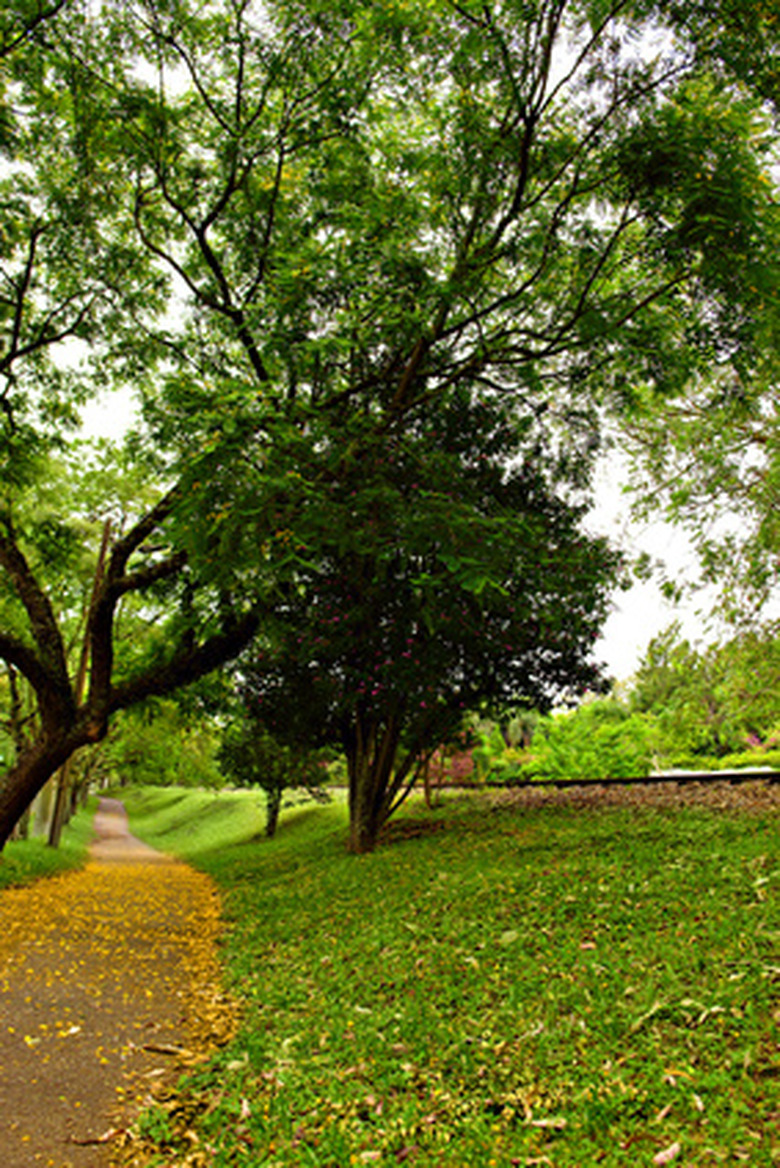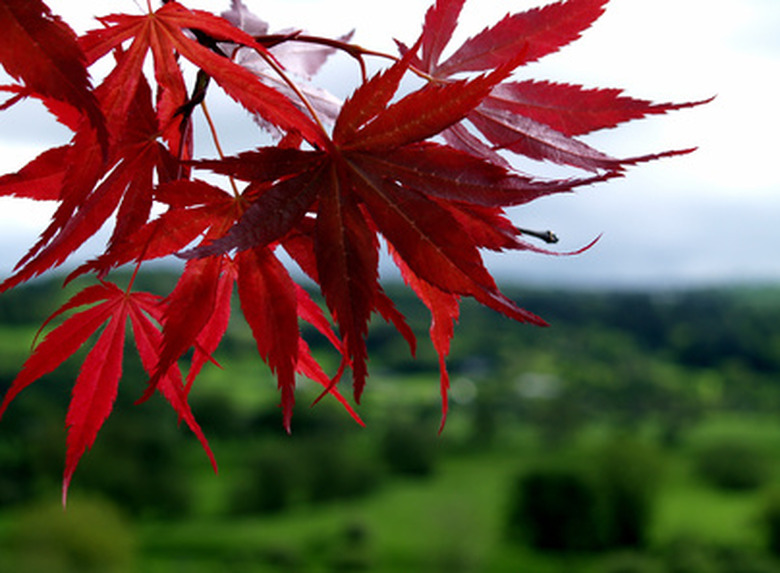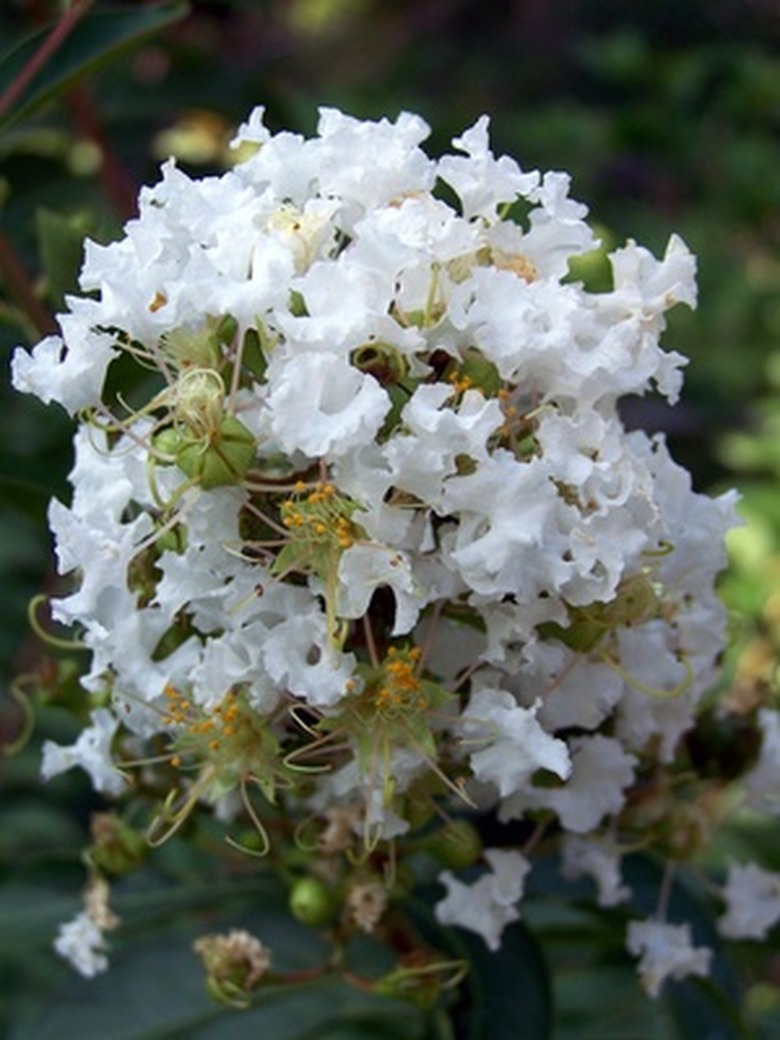Which Trees Only Grow 8 To 10 Feet Tall?
Most people think of trees as being tall. However, some trees have a mature height that is relatively short at a mere 8 to 10 feet. Of course, no one can entirely predict how tall an individual tree will grow. Weather, growing conditions, genetics, disease and a variety of other factors can cause a tree to grow taller or shorter than average.
Japanese Maples
The Japanese maple, Acer palmatum, is small and colorful. While some varieties can grow as tall as 25 feet, at least three remain between 6 and 10 feet tall. Acer palmatum 'Oshu Shidare' has pea-green bark and leaves that turn from cherry red to green and then back again. It prefers a spot in full sun to partial shade in a well-draining, slightly acidic soil. Acer palmatum 'Olson's Frosted Strawberry' has foliage that emerges strawberry red and remains tinged with pink throughout the spring. It prefers a partially shady spot with a well-draining, slightly acidic soil. Both varieties are hardy in USDA Zones 6 through 9. Acer palmatum var. dissectum is also known as the threadleaf Japanese maple. Its finely cut foliage turns a golden color in the fall. It also produces tiny reddish purple flowers in the spring. It prefers a moist but well-draining soil in full sun or partial shade and is hardy in USDA Zones 6 through 8.
- Most people think of trees as being tall.
- Acer palmatum 'Oshu Shidare' has pea-green bark and leaves that turn from cherry red to green and then back again.
Holly
Many varieties of holly and holly hybrids remain within the 8- to 10-foot range. Winterberry holly, Ilex Verticillata, grows 6 to 10 feet tall with a similar spread. It prefers full sun in USDA Zones 3 through 9. It is also known as Common Winterberry, Black Alder, Coralberry, and Michigan Holly. Deciduous holly, Ilex decidua, grows about 10 to 15 feet tall in full sun or part shade. Japanese holly, Ilex crenata, grows about 6 to 10 feet tall with a similar spread. It is hardy in USDA Zones 5 through 7. Meserve or blue holly, Ilex x meserveae, can reach heights of 15 feet but usually only reaches 8 feet tall. It can grow in USDA Zones 5 through 9 in full sun or light shade. Many hybrid cultivars of deciduous holly, Ilex verticillata x Ilex serrata, also fall in this category.
- Many varieties of holly and holly hybrids remain within the 8- to 10-foot range.
- Winterberry holly, Ilex Verticillata, grows 6 to 10 feet tall with a similar spread.
Crape Myrtle
Several cultivars of crape myrtle, Lagerstroemia indica, remain quite small, usually ranging from 5 to 10 feet tall. All are hardy in USDA Zones 5 through 9 and prefer a well-draining soil in full sun. 'Acoma' produces white flowers beginning in late June and is mildew-resistant. For bright red flowers in July through September, 'Cherokee' and 'Tonto' are good, mildew-resistant choices. Zuni produces medium to dark lavender flowers starting in early July. Several shorter choices that produce pink flowers include 'Cado,' 'Hopi,' 'Prairie Lace,' 'Pecos Pink,' 'Raspberry Sundae' and 'Pink Lace'.
Serviceberry
The Serviceberry tree, Amelanchier canadensis, is also known as a Juneberry, Shadblow, or Shadbush. Cultivars that remain about 10 feet tall include 'Prince William' and 'Sprizam.' Serviceberry trees are hardy in USDA Zones 3 through 7. They prefer a spot in full sun to partial shade in a well-draining, moist soil. Unfortunately, the tree is prone to problems with rusts, scales, aphids and mildews.
- Several cultivars of crape myrtle, Lagerstroemia indica, remain quite small, usually ranging from 5 to 10 feet tall.
- For bright red flowers in July through September, 'Cherokee' and 'Tonto' are good, mildew-resistant choices.
Other Trees
Other trees that range in height from 8 to 10 feet tall include American snowbell (Styrax americanus), bigleaf snowbell (Styrax grandifolius), colchis bladdernut (Staphylea colchica), large fothergilla (Fothergilla major), red chokeberry (Aronia arbutifolia), southern witch hazel (Hamamelis macrophylla), vernal witchhazel (Hamamelis vernalis), fragrant winterhazel (Corylorsis glabrescens), sweet bay (Lauris noblis), Chinese sumac (Rhus chinensis), smoketree (Cotinus coggygria) and sargent crabapple (Malus sargentii).


